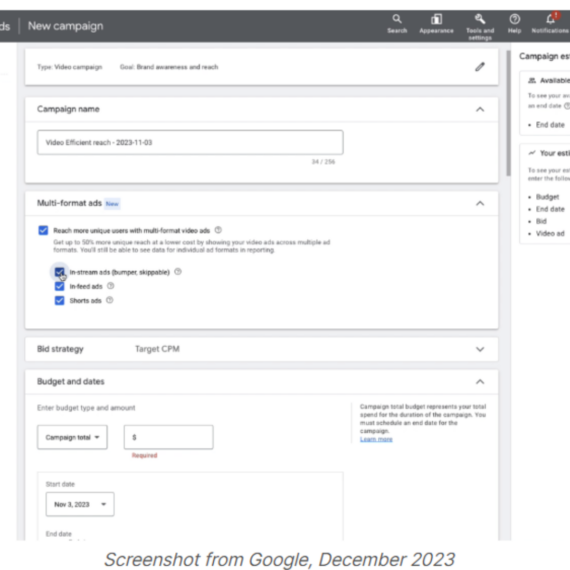Maximizing Reach on YouTube: A Deep Dive into Google Ads’ Multi-Format Video Ads
Right Shout
In Uncategorized Posted December 15, 2023
Expanding Reach on YouTube: Google Ads' Innovative Approach
Google Ads has recently made a significant leap forward in digital advertising with its introduction of multi-format ads. This new feature is designed to expand advertisers’ reach on YouTube, incorporating a blend of in-stream, in-feed, and Shorts ads. This advancement allows for a more versatile approach in reaching audiences across various YouTube formats.
Multi-Format Ad Options: A Game Changer
The latest update in Google Ads enables advertisers to include in-feed and Shorts ads in their Video Reach Campaigns (VRC). This inclusion is not just about adding variety; it’s about maximizing brand exposure while keeping the cost-per-thousand-impressions (CPM) at a minimum. Advertisers now have the flexibility to choose from bumper ads, skippable and non-skippable in-stream ads, in-feed ads, and Shorts ads. This diversity in ad formats ensures a broader reach to diverse audiences.

The Power of VRC: Optimized Campaigns for Maximum Reach
VRC is specially tailored to optimize campaigns for the highest possible unique viewer count, adhering to a specific budget and set of targeting criteria. The beauty of this system lies in its use of Google AI, which helps to deliver a more efficient and cost-effective brand exposure. Campaigns employing these three inventory types have demonstrated remarkable results, achieving on average 54% more reach at 42% lower CPM compared to in-stream-only ads.
Streamlining the Advertising Process
Setting up a multi-format campaign in Google Ads simplifies the advertising process. Advertisers no longer need to manage multiple campaigns with different ad formats. Instead, they can now streamline their efforts into one cohesive campaign. This approach not only saves time but also enhances the effectiveness of the advertising strategy.
Flexible Ad Options for Diverse Marketing Needs
The VRC update offers advertisers a range of options to tailor their campaigns:
Efficient Reach: Utilizing bumper and skippable in-stream ads for broader audience engagement.
Non-Skippable In-Stream: Ensuring full ad views.
Target Frequency: Achieving repeated exposure to a specific audience set through a mix of ad formats.
Real-World Success: The Case of Bayer
A recent campaign by Bayer illustrates the effectiveness of this approach. By integrating in-feed, in-stream, and Shorts ads, Bayer saw a 30% increase in reach and a 45% reduction in CPM compared to their previous in-stream-only campaigns.
Conclusion
Google Ads’ updates to Video Reach Campaigns are a reflection of the evolving ways people interact with YouTube content. These enhancements offer brands a novel and efficient method to achieve their marketing objectives. It’s a cost-effective strategy designed to amplify brand awareness and ensure messages resonate across a broader and more targeted YouTube audience. This development marks a new era in digital advertising, one that embraces the diverse ways in which audiences engage with online content.
FAQ
1. What are the new multi-format ads in Google Ads?
Answer: Google Ads has introduced a new feature allowing advertisers to use a combination of in-stream, in-feed, and Shorts ads in their Video Reach Campaigns (VRC). This multi-format approach enables a broader reach across different YouTube formats.
2. How do the multi-format ads enhance Video Reach Campaigns (VRC)?
Answer: The multi-format ads in VRC allow advertisers to utilize bumper ads, skippable and non-skippable in-stream ads, in-feed ads, and Shorts ads. This diversity in ad formats helps maximize brand exposure while optimizing the cost-per-thousand-impressions (CPM).
3. What is the main benefit of using the new multi-format ads in VRC?
Answer: The primary benefit is the ability to reach a larger and more diverse audience on YouTube efficiently. The use of Google AI in these campaigns helps deliver more effective and cost-efficient brand exposure.
4. How does using multiple ad formats impact campaign reach and cost?
Answer: Campaigns using three different ad formats (bumper, in-stream, and either in-feed or Shorts ads) have shown to achieve 54% more reach and a 42% lower CPM on average, compared to campaigns relying solely on in-stream ads.
5. What are some of the ad format options available in the new VRC update?
Answer: Advertisers can choose from efficient reach with bumper and skippable in-stream ads, non-skippable in-stream ads for full views, and target frequency using a mix of ad formats for repeated exposure.
6. Can you give an example of a successful campaign using these new multi-format ads?
Answer: Bayer’s recent campaign is a notable example. By integrating in-feed, in-stream, and Shorts ads, Bayer achieved a 30% greater reach and a 45% reduction in CPM compared to their previous in-stream-only campaigns.
7. Is it easier to set up and manage these multi-format ad campaigns?
Answer: Yes, the new VRC update streamlines the advertising process. Advertisers can now set up a single campaign using multiple ad formats, eliminating the need for multiple campaigns with different formats.
8. Who benefits most from using Google Ads’ new multi-format ads?
Answer: Brands and advertisers looking to maximize their reach on YouTube in a cost-effective manner will benefit significantly from these new multi-format ads. It’s especially beneficial for those aiming to enhance brand awareness across a diverse YouTube audience.
9. Are there any special requirements for using these new ad formats in campaigns?
Answer: There are no special requirements beyond the standard Google Ads setup. However, advertisers should be familiar with the different ad formats and how they can be effectively integrated into their VRC.
10. How does this change reflect the evolution of YouTube content engagement?
Answer: This update reflects the changing ways in which people interact with YouTube content. By offering a variety of ad formats, Google Ads aligns with the diverse viewing preferences of YouTube users, ensuring that advertisers can effectively reach their target audiences.





